Who were the Pilgrims? Where did they come from? And why did they come to America? Here's why your history books only tell part of the story.
Most people can name a few facts about the Pilgrims. They sailed on the Mayflower, they hosted the first Thanksgiving, and many Americans claim them as ancestors today. But who were the Pilgrims?
For such a small band of people — just 102 people sailed on the Mayflower in 1620, and only about half of them were fleeing religious persecution — the Pilgrims cast an oversized legacy on American culture today. But their full story is often simplified, if not entirely misunderstood.
For starters, they weren’t even called “Pilgrims” in their time. Though they saw the religious significance of the word, the settlers were actually called “Separatists” and then “Old Comers” before the orator Daniel Webster formally described them as Pilgrims 200 years later. And the Pilgrims’ journey from England to the New World was anything but straightforward.
Indeed, Separatists fleeing religious persecution didn’t travel to the New World first, but to Holland. They were there for about a decade before economic difficulties and fears about the corruption of their children led them to sail across the ocean. With the approval of King James — and with several economic migrants onboard — they left English shores and sailed west aboard the Mayflower in hopes of practicing their faith in peace.
Then, after 65 torturous days at sea, the Pilgrims would establish the first permanent settlement of Europeans in New England. But many of the common myths we associate with the Pilgrims are simply that: myths.
The famous Plymouth Rock, for starters, was probably not that important to the Pilgrims. Though the settlers famously dined with Native Americans during the “first” Thanksgiving, they also fought fiercely against Indigenous groups in the area and displayed their enemies’ decapitated heads after battles. And while the Pilgrims of Plymouth were central to American history for many reasons, the existence of their colony was fleeting.
Here’s everything you need to know about the Pilgrims, from their perilous voyage aboard the Mayflower to how their relationship with Indigenous people went from friendship and Thanksgiving to war and violence.
Who Were The Pilgrims?
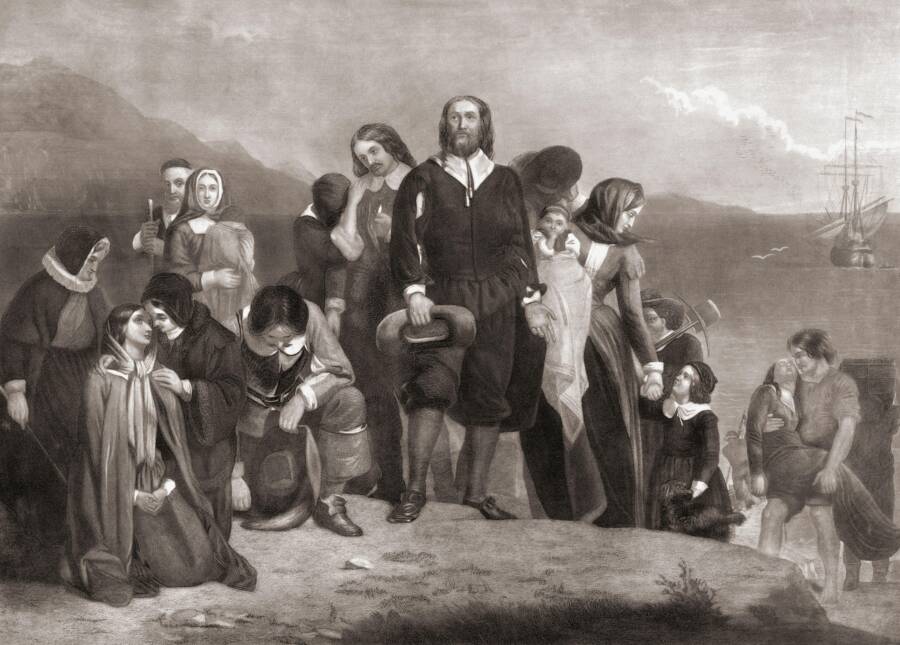
Classic Image/Alamy Stock PhotoThough they were not formally called “Pilgrims” until the 19th century, the settlers saw themselves as pilgrims.
The term “Pilgrims” is used to describe the 102 English settlers who set out for the New World in 1620 on the Mayflower. Many of them were fleeing from religious persecution they faced at home. Upon their arrival, the Pilgrims established Plymouth Colony in present-day Massachusetts. It was the first permanent settlement of Europeans in New England.
The Pilgrims struggled to survive in the New World and were famously assisted by a tribe of Native Americans, the Pokanokets. In the fall of 1621, they shared a meal with the Pokanokets, which is seen today as the foundation of the holiday that became Thanksgiving.
They remain an important part of the American story today, and many prominent Americans, from President John Adams to actress Marilyn Monroe, can trace their lineage to passengers aboard the Mayflower.
Why Are They Called Pilgrims?
The Pilgrims were not always called pilgrims. Initially, they were called “Separatists” because of their desire to separate from the English church. Later, people referred to them as “Old Comers” or the “Forefathers.” But the Pilgrims certainly saw themselves as pilgrims from the beginning, even if they didn’t explicitly call themselves that at first.
As the Plimoth Patuxet Museums report, the first baby born after the Mayflower’s arrival in the New World was named Peregrine, which means “traveler,” or, you guessed it, “pilgrim.”
And William Bradford, who would serve as the governor of Plymouth for 30 years, also used the term to refer to his fellow settlers. He used the phrase both in his poetry and to describe the Pilgrims’ decision to leave Holland and to come to the New World. Bradford wrote: “They knew they were pilgrims, and looked not much on those things, but lifted up their eyes to the heavens, their dearest country; and quieted their spirits.”
In 1820, as Britannica reports, the term “Pilgrim Fathers” stuck when it was used by orator Daniel Webster to describe the Pilgrims during the bicentennial celebration of their colony’s founding.
Where Did The Pilgrims Come From?
The Pilgrims came from England. Specifically, many of them originated from the town of Scrooby in Nottinghamshire.
By the dawn of the 17th century, England had gone through incredible religious turmoil, thanks in large part to King Henry VIII. The controversial king had separated England from the Catholic Church in the 1530s and established the Church of England but some believed that the new English church hewed too closely to the old Catholic faith.
As the Plimoth Patuxet Museums explain, some of these people were known as “Puritans.” Some, with even more extreme ideas, were known as “Separatists.” While the Puritans wanted to “purify” the church, the Separatists wanted to form separate congregations. This was a revolutionary — and very illegal — idea in England at the time.
Why Did The Pilgrims Come To America?
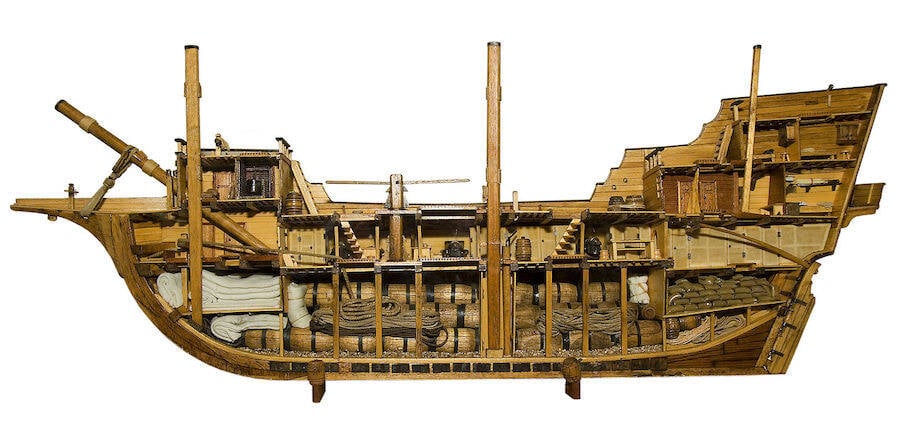
User Musphot on Wikimedia CommonsA model of a 17th-century English merchantman ship, showing the cramped and uncomfortable conditions the Pilgrims would have endured on the Mayflower.
Though it was illegal in the 1600s for anyone to belong to a church other than the Church of England, many Pilgrims still came together to form their own congregation. In Scrooby, as the Nottinghamshire County Council reports, Mayflower passengers William Brewster and William Bradford were inspired by ideas about religious separatism, which urged people to break from the English church. They and others established a separatist church, which soon caught the attention of the English authorities.
“But after these things; they could not long continue in any peaceable condition; but were hunted and persecuted on every side, so as their former afflictions were but as fleabitings in comparison of these which now came upon them,” Bradford later wrote of the persecution. “For some were taken and clapt up in prison, others had their houses besett and watcht night and day, and hardly escaped their hands; and the most were faine to fly and leave their houses and habitations, and the means of their livelihood.”
Brewster, Bradford, and other Separatists fled to Holland around 1608 to escape English persecution. But soon, they’d decide to go much further.
When Did The Pilgrims Come To America?
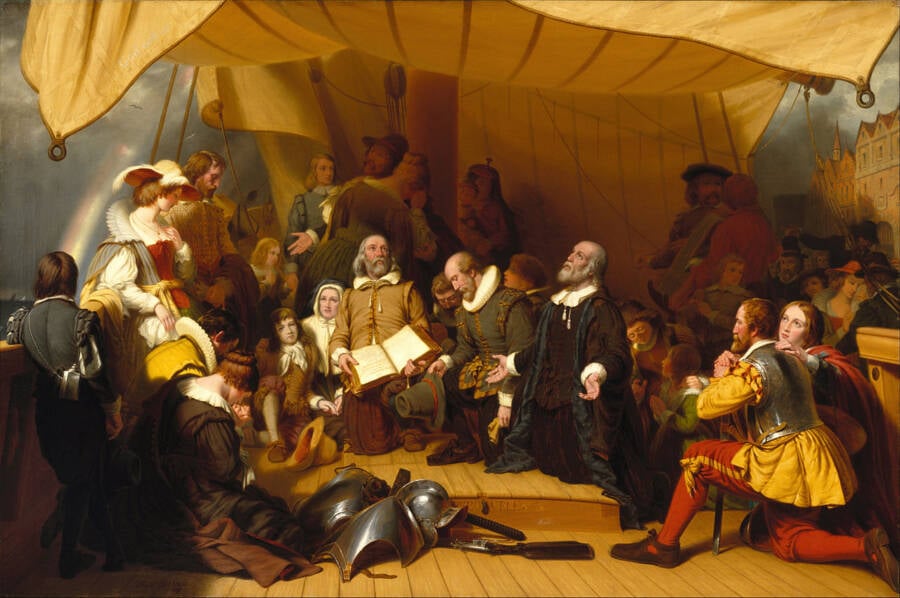
Public DomainThe 102 people who sailed to the New World on the Mayflower faced terrifyingly rough seas.
One hundred and two men, women, and children boarded the Mayflower and set sail from Plymouth, England, on September 6, 1620.
The Pilgrims had been living in Leiden, Holland, for about 12 years, but had decided that it was time to move on. It was hard for some of them to find work in the Dutch-speaking country, and many worried that their children would integrate too much into Dutch life, according to the site Mayflower 400. Plus, war between Spain and the Netherlands loomed on the horizon.
Bradford later wrote that the Pilgrims hoped to find “a better, and easier place of living” where he and the others could propagate and advance “the gospel of the kingdom of Christ in those remote parts of the world.”
And as National Geographic writes, the Pilgrims received unexpected but welcome support from King James of England. The king was eager to populate North America, so he agreed to let the Pilgrims sail abroad to practice their religion in peace. In exchange for support from investors, the Pilgrims would send goods like fur back to England.
Who Came Over On The Mayflower?
Of the 102 people who boarded the Mayflower and set sail in September 1620, just about half were “Separatists” fleeing religious persecution. The others were economically driven migrants called “Strangers.”
As HISTORY writes, the Strangers got a place on the Mayflower because of a financing deal that the Separatists struck. In exchange for financial support, the Strangers were allowed on board, even though they did not share the Separatists’ religious beliefs. They wanted to sail to the New World for economic opportunities, not because they were being persecuted.
The passengers were initially divided between the Mayflower and another ship called the Speedwell, but the Speedwell proved unseaworthy and returned to port. Some of its passengers boarded the Mayflower, and then the famous ship underwent the journey to the New World alone.
What Happened To The Mayflower?

Public DomainA depiction of the Mayflower at sea.
For 65 days, the Mayflower made its way across the Atlantic Ocean. It was often a harrowing journey. As Mayflower 400 reports, terrible storms meant that the ship had to traverse rough seas and many of its passengers were afflicted with seasickness so severe that they couldn’t stand.
“They were encountered many times with cross winds and met with many fierce storms with which the ship was shroudly shaken, and her upper works made very leaky,” Bradford later wrote, “and one of the beams in the midships was bowed and cracked, which put them in some fear that the ship could not be able to perform the voyage.”
At one point, the ship got caught in a storm so powerful that one of the Strangers was swept overboard. (To some Separatists, this was divine retribution. Bradford wrote that the young man had had the “just hand of God upon him” because he had been “a proud and very profane yonge man.”)
The voyage was difficult, and the Pilgrims had to survive on an unsatisfying and non-nutritious diet of biscuits, dried meat, and beer. But the crossing wasn’t without happy moments. During the crossing, a baby named Oceanus was born to passenger Elizabeth Hopkins.
And finally, after perilous months at sea, the Pilgrims spotted land on November 9, 1620. “Being thus arrived in a good harbor and brought safe to land, they fell upon their knees and blessed the God of heaven, who had brought them over the vast and furious ocean, and delivered them from all the perils and miseries thereof,” Bradford wrote.
But the Pilgrims hadn’t landed where they’d meant to.
Where Did The Pilgrims Land?
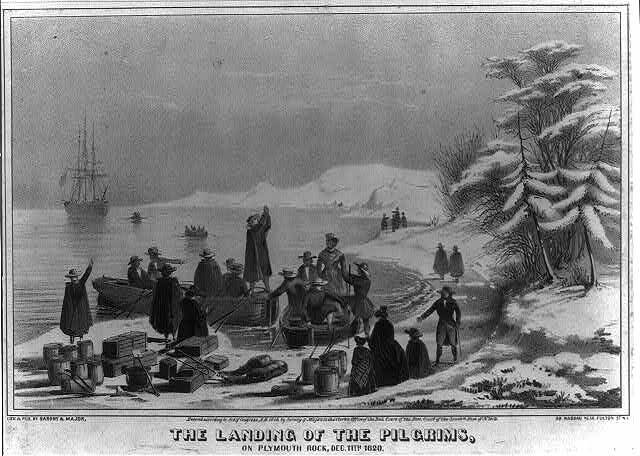
Library of Congress/PicrylA depiction of the landing of the Pilgrims in the New World.
The Pilgrims had intended to sail to Virginia Colony, which once extended from Jamestown up to the mouth of the Hudson River. They originally planned to land somewhere near present-day New York City but, instead, found themselves at the tip of Cape Cod.
This posed a problem. Some of the Strangers onboard argued that this meant that they were not bound to English law, since they were settling in a place outside of King James’ authority. Several Strangers, Bradford later wrote, “made discontented and mutinous speeches.”
To avoid a descent into lawlessness, a group of 41 men quickly organized a charter called the Mayflower Compact. According to National Geographic, the Pilgrim leadership sought to form “a civil body politick” in order to enact “just and equal laws… for the general good of the Colony.”
The pact was signed on November 11, 1620. It was the first document to establish self-government created by Europeans in the New World.
What Is Plymouth Rock?
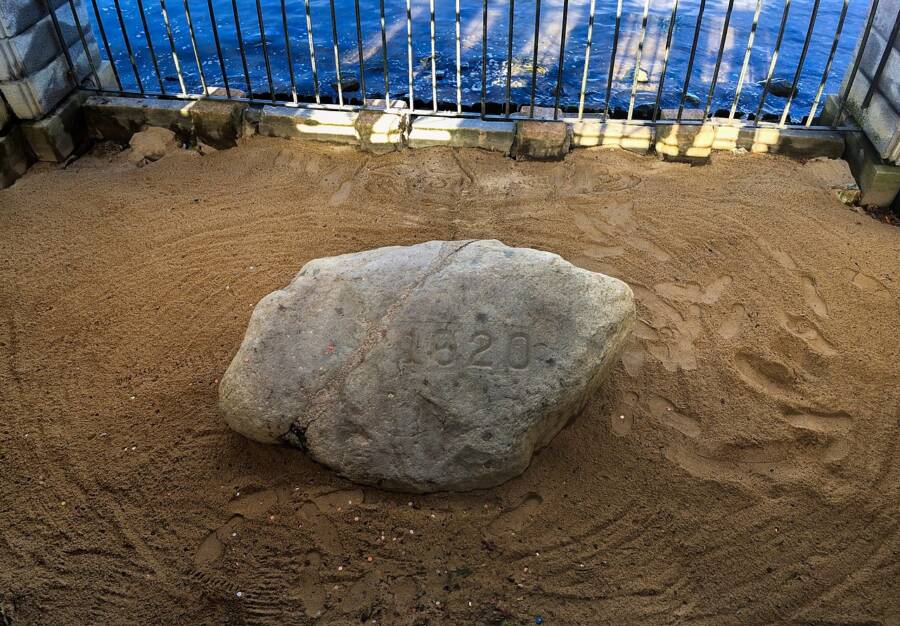
John8v12/Wikimedia CommonsPlymouth Rock is an important landmark today, but probably played a less important role in the Pilgrims’ lives.
The Pilgrims named the place where they settled Plymouth Colony after the town in England where they’d departed from months earlier. But their connection with Plymouth Rock, today a famous landmark, is tenuous.
As HISTORY reports, the Pilgrims made no written reference to stepping on any rock. It wasn’t until 1741 that Plymouth Rock took on any significance.
Then, 94-year-old Thomas Faunce, who claimed that his father had arrived in Plymouth in 1623, alleged that the 10-ton boulder in Plymouth Harbor was the exact spot where the original Pilgrims had landed. Faunce, who had learned that a wharf was going to be built over the rock, demanded to see it a final time so he could say “goodbye.”
After that, Plymouth Rock transformed into an American landmark. But its actual connections to the Pilgrims of the Mayflower are weak, as Faunce made his claim 121 years after they’d arrived.
What Difficulties Did The Pilgrims Face?
Life for the Pilgrims in the New World was extremely difficult. More than half of the settlers died during the first winter, both from inadequate shelter and poor nutrition. As the Plimoth Patuxet Museums note, the Pilgrims were not starving to death, but had consumed a salt-heavy diet while at sea, which weakened their bodies. People fell ill from pneumonia and scurvy and about two to three people died per day during their first couple of months on land.
As HISTORY notes, these conditions were particularly devastating to Pilgrim women. Of the 19 women who had boarded the Mayflower back in September 1620, just five of them had survived.
“But that which was most sad and lamentable was that, in two or three months time, half of their company died,” Bradford wrote, “especially in January and February, being the depth of winter and wanting houses and other comforts, being infected with the scurvy and other diseases which this long voyage and their inaccommodate condition had brought upon them. So, as there died sometimes two or three a day in the aforesaid time that, of 100 and odd persons, scarce 50 remained.”
How Did Pilgrims Interact With The Native Americans?

Public DomainFour months after they arrived in the New World, the Pilgrims were approached by two English-speaking Native Americans: Samoset, pictured, and Squanto.
According to the Plimoth Patuxet Museums, it took about four months for the Pilgrims to start communicating with Native Americans, who initially kept their distance from the new settlers on their land.
As National Geographic reports, the Pilgrims were approached by two Native American men in March 1621: Samoset, who had learned English from traders, and Tisquantum, better known as Squanto, who had spent years in Europe as a kidnapped slave and spoke perfect English.
With Squanto translating, the Pilgrims were able to establish a peace treaty with Massasoit, the leader of the Wampanoag, which was a confederation of a number of tribes, including the Pokanoket. Squanto also taught the Pilgrims how to plant corn, fish, and hunt animals like beavers.
The good relations with local Native Americans would not last, however. HISTORY reports that other tribes, including the Massachusetts and Narragansetts, were distrustful of the Pilgrims. And as the Pilgrims began to spread across more land, their relationship with Indigenous people — including the Pokanokets — violently deteriorated.
This eventually led to a brutal war. But first, the Pilgrims and Pokanokets famously sat down to share a meal together in what’s widely seen today as the precursor to the American Thanksgiving.
What Happened On The First Thanksgiving?

Public DomainA depiction of the first Thanksgiving, which took place between the Pilgrims and their Native American allies.
In the fall of 1621, legend states that Massasoit rushed to the Pilgrims’ aid when he heard them firing muskets. In fact, the settlers were just celebrating their first harvest. Massasoit and his men were then reportedly invited to stay for dinner. (Some dispute this, however, as Massasoit and his men would have been accustomed to hearing the Pilgrims firing guns.)
In any case, Massasoit and his warriors came to see the Pilgrims. Witness Edward Winslow later wrote that “many of the Indians coming amongst us, and amongst the rest their greatest king Massasoit, with some ninety men.”
Indeed, the Native American warriors outnumbered the Pilgrims more than two to one. Though the group likely did not feast on modern-day Thanksgiving fare like turkey, potatoes, or pecan pie, they probably enjoyed deer, seafood, pumpkin, corn, beans, and other local produce.
It was a serene moment of peace and plenty between the Pilgrims and the Native Americans. But relations between the settlers and Indigenous people in the area would soon devolve into violence.
What Was The King Philip’s War?

Public DomainA depiction of King Philip’s War, which took place in the 1670s.
As National Geographic notes, the Pilgrims had never had an entirely peaceful relationship with Indigenous people. They had allied themselves with Wampanoag people, but this meant that the Pilgrims helped the tribe fight its enemies. Both the Plymouth Colony and the Wampanoag Village displayed the body parts and decapitated heads of defeated enemies.
And as the decades passed, relations between the Pilgrims and the Wampanoag also soured. In 1675, the Pilgrims went to war with Metacomet, the son of Massasoit who had taken over leadership of the Wampanoag people. Metacomet was fed up with recognizing English authority, and he also wanted to prevent the settlers from taking more Indigenous land. The Pilgrims called Metacomet “King Philip,” and the ensuing “King Philip’s War” led to the deaths of thousands of people.
HISTORY reports that 5,000 were killed during the conflict (including Metacomet), and that three quarters of the dead were Native Americans. The settlers prevailed, and their victory paved the way for more violence against Indigenous people across North America that would endure for centuries.
What Happened To The Pilgrims And Their Descendants?
The small colony of Pilgrims fractured very early on. By the 1630s, several prominent members left to form their own communities. King Philip’s War also took an economic toll on the colony, and Plymouth was ultimately absorbed into the larger Massachusetts Bay Colony in the 1690s.
But for a colony that lasted less than a century, the Pilgrims in Plymouth had an oversized impact. Scores of other repressed people followed their example and fled England in the 1620s and 1630s. These included Puritans led by John Winthrop, who established the Massachusetts Bay Colony.
And the Pilgrims of the Mayflower hold an important place today in the American story. Not only can many prominent Americans, from Julia Child to James Garfield, trace their lineage to the Pilgrims, but the Pilgrims also represented the beginnings of the future United States.
They established the first permanent settlement of Europeans in New England and drew up the first self-government of Europeans in the New World. The Pilgrims’ historical account of suffering, survival, and Thanksgiving also plays an important role in the American story.
Of course, part of that story is also how they interacted with Native Americans — for better and for worse. Both the Pilgrims’ treaties with Indigenous people and their violence against them should be remembered as an important part of their legacy as well.
After learning about the Pilgrims, enjoy this list of fascinating facts about life in ancient Rome. Or, dive into these surprising facts about the Victorian era.






